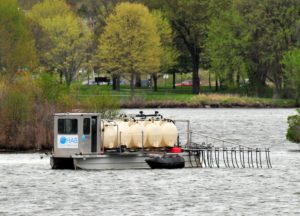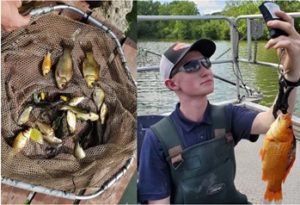Edina
ABOUT
Lake Cornelia and Lake Edina are shallow lakes with poor water quality that are on the state’s impaired waters list for excess nutrients. The Nine Mile Creek Watershed District is working to control nutrient levels (specifically phosphorous) in Lake Cornelia and Lake Edina.
Project Summary
The Nine Mile Creek Watershed District (District) and City of Edina are completing a multi-phased project to improve the health of Lake Cornelia and Lake Edina. As part of the overarching project, the District and City of Edina have completed several projects:
- 2017-2022: the City of Edina conducted annual lake herbicide treatments on Lake Cornelia to control curly leaf pondweed
- 2020: NMCWD ordered an in-lake alum treatment on Lake Cornelia
- 2021: The District installed a stormwater filtration vault located in Rosland Park
- 2023: The District and the City of Edina retrofitted Lynmar Basin to hold and treat more stormwater before it reaches Lake Edina
Beyond this, the District is working with WSB and Associates to manage goldfish in the Lake Cornelia system. The District will also assess the need to improve oxygen conditions in the lake, after evaluating monitoring data.
Curly-leaf Pondweed Herbicide Treatment
Curly-leaf pondweed is an invasive aquatic plant. The City of Edina is conducting herbicide treatments to reduce the amount of curly-leaf pondweed in Lake Cornelia. Reducing the amount of the invasive plant will help protect and improve the native aquatic plant community and reduce the amount of phosphorus released into the water when the invasive plant dies off and decays in mid-summer. Herbicide treatments are done in early spring when the water temperature in the lake is generally between 50-60o F. This is when the herbicide is most effective and limits damage to native plants, which start growing later than curly-leaf pondweed.
In-lake Alum Treatment

Alum treatments can help control phosphorous levels in lakes. Phosphorous is a nutrient that fuels algae growth. Trained contractors apply alum using specialized equipment; this equipment ensures the precise placement of the material in the lake. On contact with the water, the liquid alum forms a fluffy aluminum hydroxide precipitate called floc. Aluminum hydroxide (the main ingredient of common antacids like Maalox) binds with the phosphorus to form a compound that does not dissolve in water. The bound phosphorus can no longer fuel algae growth. As the floc settles to the bottom, it removes phosphorus and particles from the water, leaving the lake clearer. The floc then forms a thin layer on the bottom of the lake, and binds with phosphorus in the sediment. The result is a reduction in the frequency and intensity of nuisance algal blooms.
HAB Aquatic Solutions applied alum at Lake Cornelia on May 21, 2020.
Goldfish Management

To help improve water quality and the ecological health of Lake Cornelia and Lake Edina, the District is undertaking goldfish management.
Goldfish are an invasive species of fish that cause water quality problems due to their bottom feeding behavior. They stir up lake bottom sediments which reduces water clarity and releases phosphorus. They also uproot aquatic vegetation, destroying habitat for waterfowl and aquatic communities.
The goldfish population was likely started with the release of pet goldfish into one or more of the lakes within the system. Awareness and public education are needed to prevent this from happening in any small ponds that could perpetuate the invasive goldfish population in the Cornelia chain.
A 2018 fish summary indicated that while there were carp, another invasive bottom-feeding fish, in the Lake Cornelia system, they were not abundant. Goldfish, on the other hand, were plentiful and at a level where management of the population is recommended for water quality purposes.
A follow-up goldfish and carp study was completed in 2020 to assess goldfish and carp levels, track inter-waterbody movement through the Lake Cornelia system and test management/removal methods. Surveyors found a large number of young of the year goldfish in the lake, indicating successful goldfish recruitment (survival to the juvenile stage).
The District will continue to study and manage the goldfish population in the Lake Cornelia system, to determine the best methods for goldfish removal and population management.
The District received grant funding for the goldfish studies on Lake Cornelia from the Minnesota Board of Water and Soil Resources through the Clean Water, Land and Legacy Amendment and from Hennepin County through their Aquatic Invasive Species Prevention program.
Cornelia Lake System fisheries assessment for 2020 Report
District Goldfish Study Featured
In this Minnesota Bound episode (filmed in 2020) you can see the goldfish research team in action starting at around 1:20, as they collect information on goldfish in the Lake Cornelia system in Edina.
The City of Edina takes a look at water quality in Lake Cornelia and goldfish in this featured video.
How can you help Lake Cornelia and Lake Edina?
If you have unwanted aquarium fish or plants, never dump them in a lake, creek or pond. Always surrender them at a re-home event.
You can also Adopt a Drain to keep pollution from entering the water in the first place. Learn more at mn.adopt-a-drain.org.
Studies and Reports
Visit the Lake Cornelia and Lake Edina Study page to read the lake water quality study and feasibility reports.
Questions?
Contact Jordan Wein, Water Resources Project Manager, at 952-800-8307 jwein@ninemilecreek.org
